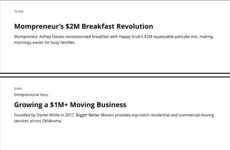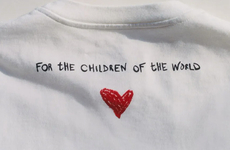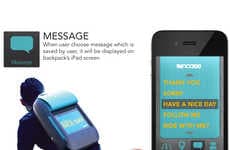
Jordy E — May 18, 2012 — Social Good
References: porteur.cc
Jimmy Ostholm, the Founder and CEO of The Porteur Foundation, shares his insight and experience with the charitable organization. The Porteur operation is based upon a one-for-one mantra, donating one bicycle to a project in a developing country with every two-wheeler sold.
Four Questions with Jimmy Ostholm
1. How did the idea for the business model come about?
I believe we all need and therefore search for a cause. We like when things have a purpose. And we like it even more when the purpose goes beyond our own selfish satisfaction. That is at least how it works for me. Doing what I am doing now is a dream come true. To develop a bicycle and creating a brand from scratch is a rare opportunity. Given that possibility I could not neglect the fact that our core business is manufacturing—and although a bicycle beats a car in every sense, the whole concept didn’t feel solid until we found our true cause. Yes, our bike looks great. Really great if you ask me. And yes, we have been innovative in some ways, developing the scalable carrier system for the porteur—and by that targeting an open market space. Even so, I could not motivate myself to say it was enough. Enough to bring yet another bicycle to the market.
Reading an article arguing for the need of bicycles in developing countries and what a defining roll the bicycle has in these countries: giving young girls possibilities to go to school, doctors a faster journey from village to village and families a vehicle helping them carry more products with less effort to markets places, gave me the idea of supporting this need. A need estimated to a 100.000.000 bicycles. Finding that cause felt great and from that to: One for One, the step wasn’t that far. I wanted a simple, no fuss promise. A promise easy to communicate. Easy to understand and easy to deliver on. So, for every bicycle sold we donate another to a project in a developing country. One for One we pay it forward. I’m really proud of our promise and equally proud that Unicef found it so good and satisfying that we could join forces in this cause.
2. How did you decide to join this sector?
For 12 years I have run my own business in some way. As a partner most of the time, first at an advertising agency and for the past five years as a brand and design consultant. Three years ago we started working with the bicycle brand Bianchi. The hero brand of my youth. Working with it brought me back to the years I was working on IKEA and the satisfaction following working with a real product. Something that actually matters in everyday life. During the years with Bianchi I had a growing feeling telling me to leave the consultancy world. I can’t really say when my mind started to play with the idea of a new bicycle brand but soon I couldn’t get the idea out of my mind and, well, from that point there was really no turning back.
3. How do you get your inspiration
How, I know it’s a cliché but, I think life is inspirational. Not in the sense that I wake up every morning and cheer myself with the happiness of being healthy and alive, not at all. But I have trained myself to just pause a moment, like a snap shot, and really taking in everything in that picture. Having a few moments like that gives me instant inspiration. Just cruising around on my bike, really slow is another great way to get inspired. The world is greatly discovered on two wheels.
4. How do you reset yourself to be creative? Do you have any rituals?
Can we really reset our minds? And should we? Or is a buffered mind a foundation for creativity? I don’t know if I ever reset myself. Or my mind. And I don’t think I have any rituals. The closest may be the moment of stillness—it could really last for a few days—between the first thrilling feeling, when you know you have found “something” and the moment when you have to deal with your idea, bring it forward and confront it with the brutal reality. I need that moment to prepare myself, because not every idea will be brought to life, but prior to the inquisition every idea is full of life.
Four Questions with Jimmy Ostholm
1. How did the idea for the business model come about?
I believe we all need and therefore search for a cause. We like when things have a purpose. And we like it even more when the purpose goes beyond our own selfish satisfaction. That is at least how it works for me. Doing what I am doing now is a dream come true. To develop a bicycle and creating a brand from scratch is a rare opportunity. Given that possibility I could not neglect the fact that our core business is manufacturing—and although a bicycle beats a car in every sense, the whole concept didn’t feel solid until we found our true cause. Yes, our bike looks great. Really great if you ask me. And yes, we have been innovative in some ways, developing the scalable carrier system for the porteur—and by that targeting an open market space. Even so, I could not motivate myself to say it was enough. Enough to bring yet another bicycle to the market.
Reading an article arguing for the need of bicycles in developing countries and what a defining roll the bicycle has in these countries: giving young girls possibilities to go to school, doctors a faster journey from village to village and families a vehicle helping them carry more products with less effort to markets places, gave me the idea of supporting this need. A need estimated to a 100.000.000 bicycles. Finding that cause felt great and from that to: One for One, the step wasn’t that far. I wanted a simple, no fuss promise. A promise easy to communicate. Easy to understand and easy to deliver on. So, for every bicycle sold we donate another to a project in a developing country. One for One we pay it forward. I’m really proud of our promise and equally proud that Unicef found it so good and satisfying that we could join forces in this cause.
2. How did you decide to join this sector?
For 12 years I have run my own business in some way. As a partner most of the time, first at an advertising agency and for the past five years as a brand and design consultant. Three years ago we started working with the bicycle brand Bianchi. The hero brand of my youth. Working with it brought me back to the years I was working on IKEA and the satisfaction following working with a real product. Something that actually matters in everyday life. During the years with Bianchi I had a growing feeling telling me to leave the consultancy world. I can’t really say when my mind started to play with the idea of a new bicycle brand but soon I couldn’t get the idea out of my mind and, well, from that point there was really no turning back.
3. How do you get your inspiration
How, I know it’s a cliché but, I think life is inspirational. Not in the sense that I wake up every morning and cheer myself with the happiness of being healthy and alive, not at all. But I have trained myself to just pause a moment, like a snap shot, and really taking in everything in that picture. Having a few moments like that gives me instant inspiration. Just cruising around on my bike, really slow is another great way to get inspired. The world is greatly discovered on two wheels.
4. How do you reset yourself to be creative? Do you have any rituals?
Can we really reset our minds? And should we? Or is a buffered mind a foundation for creativity? I don’t know if I ever reset myself. Or my mind. And I don’t think I have any rituals. The closest may be the moment of stillness—it could really last for a few days—between the first thrilling feeling, when you know you have found “something” and the moment when you have to deal with your idea, bring it forward and confront it with the brutal reality. I need that moment to prepare myself, because not every idea will be brought to life, but prior to the inquisition every idea is full of life.
Trend Themes
1. One-for-one Business Model - Disruptive innovation opportunity: Explore the potential of implementing a one-for-one business model in various industries to create a social impact while driving sales.
2. Purpose-driven Brands - Disruptive innovation opportunity: Build purpose-driven brands that resonate with consumers and align with their desire for social impact.
3. Bicycles in Developing Countries - Disruptive innovation opportunity: Develop innovative solutions to provide bicycles to developing countries, enabling access to education, healthcare, and better economic opportunities.
Industry Implications
1. Retail - Disruptive innovation opportunity: Incorporate a one-for-one business model in retail, where each purchase leads to a charitable donation, creating a positive brand perception.
2. Manufacturing - Disruptive innovation opportunity: Collaborate with charities or organizations to develop bicycles specifically designed for developing countries, addressing their unique needs and challenges.
3. Marketing and Advertising - Disruptive innovation opportunity: Help purpose-driven brands amplify their message and raise awareness about the social impact they are creating through strategic marketing and advertising campaigns.
2.7
Score
Popularity
Activity
Freshness























